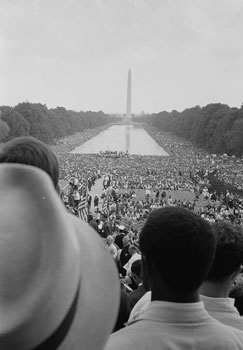recent arrivals
The Civil Rights Movement in Springfield
Though the city of Springfield played a crucial role in the abolitionist movement and attracted African Americans during the Great Migration, racial discrimination shaped the geography and social patterns of the city through the twentieth century.
African American migrants to Springfield during the first half of the twentieth century found a vibrant black community dating to the mid-1800s. These migrants were attracted by the prospect of work in the area's industrial economy and the relatively low cost of living compared to other urban centers in the North. However, racial hostility and economic competition from newly-arrived immigrants limited the prospects for most. Some African Americans with the opportunity to develop valuable skills and secure steady wages did make their way into the middle class.
The majority of the African-American community in Springfield was confined to three inner city neighborhoods, where blacks paid higher rents and lived in lower-quality housing than their white counterparts. Landlords and realtors in Springfield regularly made excuses to keep African-American residents from moving into white neighborhoods. 1 At the same time, employers made similar excuses to avoid hiring African Americans for most skilled jobs and supervisory positions, while the Springfield school board neglected the increasingly dilapidated schools in the African-American neighborhoods. 2 This widespread discrimination kept the majority of Springfield's African Americans living at or below the poverty line into the 1960s.
The modern civil rights movement mobilized black and white activists alike to demand legal, political and social equality for all Americans. In the aftermath of the Supreme Court's 1954 decision in Brown v. Board of Education ruling racial segregation unconstitutional, boycotts and protest marches across the South brought national attention to the issue of civil rights. By the 1960s, the fight for racial equality was underway across the country.
In June 1961, the NAACP began to lobby the Massachusetts Commission against Discrimination to correct the racial imbalance in Boston schools. Over the next three years, as the state failed to respond to the NAACP's demands, the issue became front-page news and groups throughout the state began lobbying for desegregation. In January 1965, Springfield businesswoman Mary Barksdale filed suit against the Springfield School Committee, and a state court ordered the city to find a way to desegregate its schools. Six months later the Massachusetts legislature passed the State Racial Imbalance Act aimed at desegregating schools across the Commonwealth. On July 13, however, an appeals court ruled the Springfield decision unconstitutional.
Three days later, police beat a black man outside of a Springfield nightclub and the tension that had been percolating beneath the surface for months exploded into a race riot. Following the riot, and for the rest of the summer, the African-American community staged sit-ins and protest marches across the city demanding an official investigation into police violence against blacks. A full investigation was not forthcoming, but the events of the summer of 1965 prodded city officials to renew their efforts at school desegregation. Over the next few years, Springfield undertook a program of redistricting, school construction, and the reassignment and transportation of students to improve racial integration.
School desegregation and the provision of equal access to education for all Americans was just one aspect of the modern civil rights movement. As a consequence of black leadership and organization, court rulings and new laws during the 1950s and 1960s remade the legal and political norms that had relegated African-American citizens to second-class status. Still, the slow pace of school desegregation and persistent problems with inferior housing and narrow economic opportunities demonstrate the limited power of courts and legislatures to change social patterns. There have been improvements over the past few decades, but African Americans demanding social equality have struggled against a culture of racial prejudice and discrimination.
1 Housing Discrimination in the Springfield-Holyoke-Chicopee Metropolitan Area: Report on Massachusetts . Massachusetts Advisory Committee to the U.S. Commission on Civil Rights. Washington, DC. December, 1966, p. 5 and pp. 30-35.
2 Housing Discrimination in Springfield , p. 9, 12, 29.
